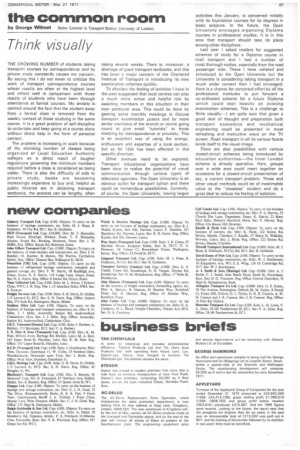Think visually
Page 69

If you've noticed an error in this article please click here to report it so we can fix it.
by George Wilmot Senior Lecturer in Transport Studies, University of London..
THE GROWING NUMBER of students taking transport courses by correspondence and by private study constantly causes me concern. By saying this I do not mean to criticize the work of transport correspondence courses whose results are often at the highest level and reflect well in comparison with those results of students who have been through attendance at formal courses. My anxiety is centred around the fact that the student away from a formal class is removed from the weekly contact of those studying in the same course. It is a great problem of self-discipline to undertake and keep going at a course alone without direct help in the form of personal contact.
The problem is increasing in scale because of the shrinking number of classes being organized at Local Education Authority colleges as a direct result of tougher regulations governing the minimum numbers required before a class is considered as being viable. There is also the difficulty of aids to private study, books are becoming increasingly expensive to buy and, helpful as public libraries are in obtaining transport textbooks, the process can be lengthy, often taking several weeks. There is, moreover, a shortage of good transport textbooks, and this has been a major concern of the Chartered Institute of Transport in introducing its new examination schemes quickly.
To alleviate the feeling of isolation I have in the past suggested that local centres can play a much more active and helpful role by assisting members in this situation in their own particular area. This could be done by gearing some monthly meetings to discuss transport examination posers and by more senior members of the branch or centre going round to give small "tutorials" to those studying by correspondence or privately. This is an excellent way of using the energy, enthusiasm and expertise of a local section, but so far little has been effected in this specific direction.
Other avenues need to be explored. Transport educational organizations have been slow to realize the potential of visual communication through various types of television agencies. The Open University is an obvious outlet for transport tuition and there could be tremendous possibilities. Currently, of course, the Open University, having begun activities this January, is concerned initially with its foundation courses for its degrees in basic subjects. In the future, the Open University envisages organizing Diploma courses in professional studies. It is in this area that transport should take its place among other disciplines.
Last year I asked readers for suggested schemes of study for a Diploma course in road transport and I had a number of most thorough replies, especially from the road passenger side. These I have collated and introduced to the Open University but the University is considering taking transport in a much wider context than I had envisaged: Here is a chance for concerted effort by all the professional institutes to put forward a co-ordinated scheme for a future Diploma which could lean heavily on existing examination schemes. This is a challenge to think visually-.---1 am quite sure that given a good deal of thought and preparation both transport economics and mechanical engineering could be presented in most refreshing and instructive ways on the TV screen. Road transport in all its various facets lends itself to the visual image.
There are also possibilities with various closed-circuit schemes being introduced by education authorities-the Inner London scheme is already operative. Here, groups over a wide area could meet together on occasions for a closed-circuit presentation of say, a current transport problem. These and other visual methods could be of inestimable value to the "classless" student and do a great deal to reduce his feeling of isolation.






























































































































